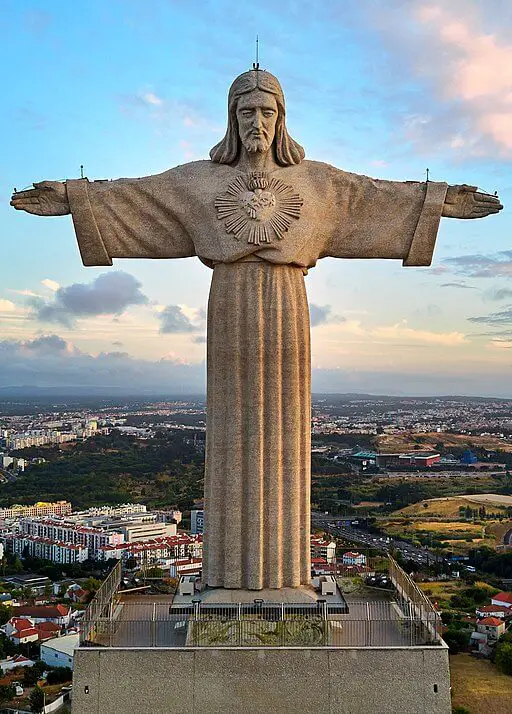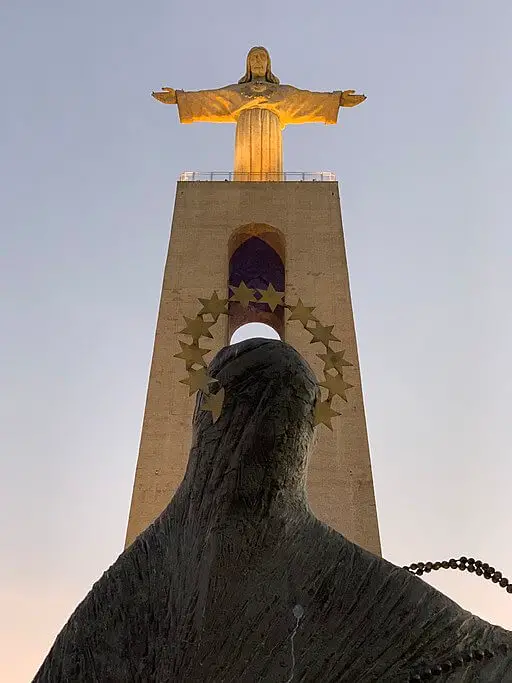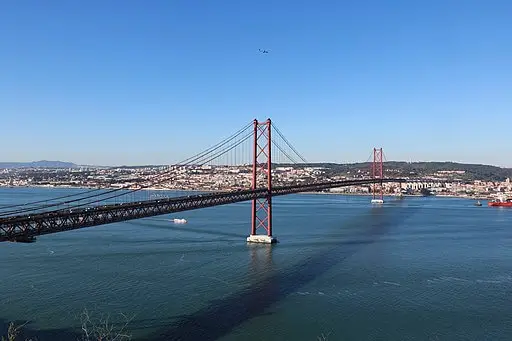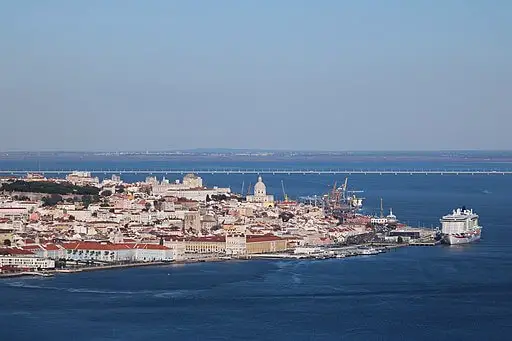Here’s what you need to know to visit Cristo Rei – Portugal’s Christ Statue, across the river from Lisbon.

How tall is Cristo Rei?
The statue of Cristo Rei stands on an isolated hilltop 133 meters above sea level.
The pedestal was designed by architect Antonio Lino and and stands 82 meters (269) feet.
It has four arches and a flat platform that support the 28 meter (92 feet) tall statue of Christ that was sculpted by Francisco Franco de Souza.
Like the statue of Cristo Redentor in Rio de Janeiro, Portugal’s statue of Christ stands in the form of a cross, with arms open as if embracing the city of Lisbon across the Tagus River.
Why was Portugal’s Cristo Rei Statue built?
In 1934 the Cardinal Archbishop of Lisbon visited Christ the Redeemer in Rio de Janeiro and started thinking about the possibility of building a similar monument in Portugal.
Grateful that Portugal had remained neutral and avoided the horrors of World War II, the Portuguese Roman Catholic Church funded and built this monument, dedicating it to the Sacred Heart of Jesus.

Construction started in 1950 and was completed in 1959.
Today it is a popular pilgrimage site for Portuguese Catholics as well as tourists looking for a view of Lisbon.
The Christ the King statue was built seven years before the 25 of April Bridge.
Originally, the bridge was called the Salazar Bridge – named after the Prime Minister and dictator who had steered Portugal into neutrality and away from war.
But over the years autocracy became too much, and the Portuguese craved democracy.
On the 25 of April, 1974, the military seized control of the Portuguese government and turned it over to the people in the Carnation Revolution.
As a result, the bridge eventually came to be known as the 25 April Bridge, instead of bearing the name of a dictator, and Portugal eventually became a democracy.

The best views of the 25 April Bridge are from the Cristo Rei viewing platform, or from the grounds of the Santuario de Cristo Rei.
For a close-up view of the underside of the bridge, go to the LX Factory in west Lisbon (which is basically at the other end of the bridge.
See more with my article, Is the LX Factory worth visiting?
If you are interested in learning more about Lisbon’s iconic bridges, read my A guide to Lisbon’s most famous bridges
How to get to the Christ the King statue?
Praceta de Cristo Rei 27A, Almada, Portugal – across the river from Lisbon, on the south bank of the Tejo River
GPS coordinates: 38.67886720851837, -9.171390288748984
Public transportation from Lisbon
From Cais do Sodré take the ferry to Cacilhas. The cost is €1.30 each way for the seven-minute ferry ride with a Viva Viagem card.
When the ferry arrives, go to the left for the Sul do Tejo bus station.
Bus 101 will take you to Santuario do Cristo Rei, but the bus does not accept the green Viva Viagem card. Pay cash €1.45, or use a white Viva Viagem card.
Buses depart roughly every thirty minutes.
Walking from the ferry
Walking is not recommended. The trip is uphill and takes roughly an hour, some of it through neglected areas, and there is not much of interest to see.
Driving from Lisbon
The trip across the 25 April Bridge will take you roughly a half-hour, and you should expect to pay a toll of €1.80 when returning to Lisbon.
Exit the A2 at A38 and then head north toward Pragal and Sanctuary of Christ the King.
Can you go to the top?
Visitors can go to the viewing platform at the top of the pedestal and stand at Christ’s feet.
On a clear day you can see as far as Sintra 24 km (15 miles) to the northwest, and possibly make out the Castle of the Moors.
To learn more about Sintra, a town you should not miss, read my How to plan a day trip or overnight trip to Sintra from Lisbon
Serra da Arrabida lies 27 km (17 miles) to the south. Almada is due east.
An elevator takes visitors almost to the top of the pedestal.
Upon exiting the elevator, there is a chapel and a gift shop, as well as a flight of 59 stairs to finally reach the viewing deck, which is enclosed with tall iron bars in order to prevent accidents.
Those with limited mobility won’t be able to get to the top but many say pictures from the grounds of the Cristo Rei are just as good.
Within the sanctuary park, you will find flower and vegetable gardens set up on arbors.
Visitors can walk the 14 Stations of the Cross, picnic on the benches (or eat in the café), and enjoy impressive statues such as the large cross donated by the Sanctuary of Our Lady of Fátima and the nearby statue of the Virgin Mary.
Visitors are also welcome to visit the Church of Cristo Rei inside the base of the statue. There is no charge to go in the church.

Opening Hours
The monument is open every day, from 10 am until 7 pm.
Masses are held Wednesdays at 5 pm, Saturdays at noon and 5 pm, Sundays and Holy Days at 11:30 am and 5 pm.
Official website: Home – . (cristorei.pt)
Admission
Children under 7 are free.
Tickets for children 8 to 12 are €3.
Ages 13 and up pay €6.
The Lisboa Card is not accepted here. For more information on the Lisboa Card, see my Lisboa Card | Everything you need to know
What’s nearby?
I highly recommend that if you go to Cristo Rei, you continue south to the beaches of Costa da Caparica – one of my favorite stretches of beach in the world.
To learn more, Explore Lisbon’s beaches on the Costa da Caparica You can get there by choosing a different bus once you get off the ferry.
In the town of Cacilhas near the ferry port, you will also find the Dom Fernando II e Glória – the last sailing ship used by the Portuguese Navy. You can visit the restored ship for €4.
World’s largest Christ statues:
- Jesus Buntu Burake (Jesus Christ Blessing) in South Sulawesi, Indonesia, is the tallest Christ statue in the world now. It was completed in 2015 and stands 40 m tall and is on top of the Buntu Burake hill, 1750 feet above sea-level.
- Christ the King, Swiebodzin, Poland – is the world’s second largest monument to Christ, built in 2010. It is 33 m tall (108 feet). If you include the mound it stands on, the statue is 52.7 meters tall (172 feet). It is also the only Jesus statue with wifi and an antennae.
- Cristo de la Concordia – Cochabamba, Bolivia, 34.2 meters (112 feet), standing atop a 6.2 meter pedestal.
- Cristo Rey – Tlalnepantla de Baz, Mexico measures 33 meters (108 feet)
- Christ of Vung Tao, Vung Tao , Vietnam is 32 meters (105 feet) tall
- Sacred Heart of Jesus – Roxas, Capiz, Philippines, 31 m, 101 feet. This statue is painted.
- Christ Blessing – Manado, Indonesia, 30 m (98 feet) on a 20 m pedestal
- Cristo Redentor – Rio de Janeiro, Brazil 30 meters (98 feet). Built in 1931, is probably the most famous statue of Christ on the planet.
- Cristo Rei, Almada, Portugal – 28 meters (92 feet), standing on an 82 meter pedestal (269 feet)
Thank you for reading about Cristo Rei. I am not affiliated with any of the businesses mentioned in this article.